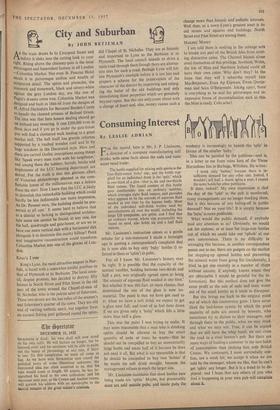City and Suburban
By JOHN BETJEMAN As the train draws in to Liverpool Street and before it sinks into the cutting look to your right. Rising above the chimney-pots is the most extravagant and benevolent fantasy in, all London --Columbia Market. Not even St. Pancras Hotel excels it in picturesque outline and wealth of sculptured detail. The spires and pinnacles, the Ironwork and stonework, black and silvery-white _against the grey London sky, are like one of Pugin's dreams come true. Columbia Market was designed and built in 1866-68 from the designs of H. Alfred Darbishire for Baroness Burdett-Coutts to benefit the cheated artisans of Bethnal Green. The idea was that here honest dealing should go on without any swearing. It cost £200,000 even in those days and if you go in under the gate-house You will find a cloistered walk leading to a great market hall. The hall itself has granite columns supported by a vaulted wooden roof and lit by huge windows in the Decorated style. Here and there are carved Gothic inscriptions saying things like 'Speak every man truth with his neighbour,' and among them the ladders, barrels, bricks and Implements of the LCC housing department are stored. For the truth is that this glorious effort of Victorian philanthropy planned in the com- fortable house of the millionairess was a failure from the start. Now I learn that the LCC is likely to demolish this remarkable building which could hardly be less fashionable nor more impressive. As Dr. Pevsner says, 'the building should be pre- served at all cost.' It seems hard to believe that in a district so lacking in distinguished architec- ture some use cannot be found, at any rate, for the hall, quadrangle and gate-house, or are we to have one more vertical slab with a horizontal slab alongside it to dominate this murky hilltop? Paint and imaginative reconstruction could transform Columbia Market into one of the glories of Lon- don.
KING'S LYNN
King's Lynn, the most attractive seaport in Nor- folk, is faced with a somewhat similar problem to that of Plymouth at its Barbican. The local coun- cil, despite protests, has decided to destroy fifty houses in North Street and Pilot Street in the old part of the town around the Chapel-of-ease of St. Nicholas, who is the patron saint of fishermen. These two streets are the last relics of the seamen's and fishermen's quarter of the town, They are old and of varying esthetic merit, but together form an ancient fishing port gathered round the splen-
did Chapel of St. Nicholas. They are as historic and important to Lynn as the Barbican is to Plymouth. The local council intends to drive a main road through them though there are alterna- tive sites for such a road. Perhaps Lynn will fol- low Plymouth's example before it is too late and prepare a scheme for the preservation of the character of the district by improving and enlarg- ing the better of the old buildings and only demolishing those properties which are genuinely beyond repair. But this can only come about with a change of heart and, alas, money causes such a
change more than historic and aesthetic interests. Well then, as a town Lynn's greatest asset is its old streets and squares and buildings. North Street and Pilot Street are among them.
MAKING MONEY
I am told there is nothing in the coinage acts to hinder any part of the British Isles from mint- ing distinctive coins. The Channel Islands alone avail themselves of this privilege. Scotland, Wales, the Isle of Man and Northern Ireland could all have their own coins. Why don't they? In the hope that they will I subscribe myself lain MacBetjeman, Evan Ap Etjeman, Ewan Quetje- man and Sean O'Betjemedn. Joking apart, there is everything to be said for picturesque and in- expensive forms of decentralisation such as this. the Mint is ready. Celts arise !






































 Previous page
Previous page